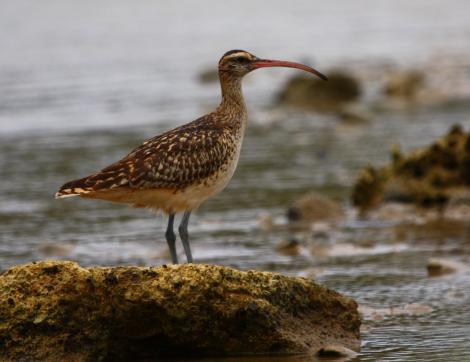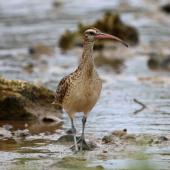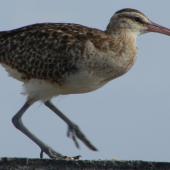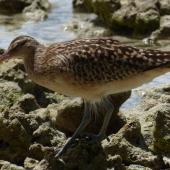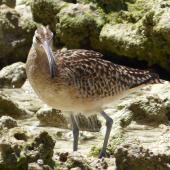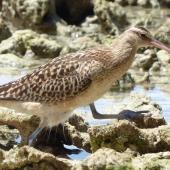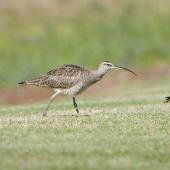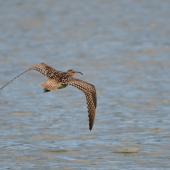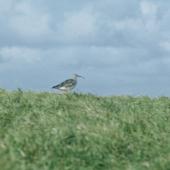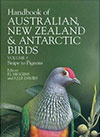Bristle-thighed curlew
Numenius tahitiensis (Gmelin, 1789)
Order: Charadriiformes
Family: Scolopacidae
Other names: bristlethighed curlew, bristle thighed curlew, kivi
Geographical variation: Nil
Bristle-thighed curlews are large shorebirds that mainly spend the non-breeding season on tropical Pacific atolls. A few overshoot, and there are three records from the subtropical Kermadec Islands north east of New Zealand. Bristle-thighed curlews are similar in size and body shape ot whimbrel, mainly differing in overall plumage colouration (orange-buff cf. brown) and cinnamon-coloured rump. The bristly feathers referred to in the bird’s name are difficult to see in the field.
Identification
The bristle-thighed curlew is about the size of a godwit, differing in having a down-curved bill and a pale stripe down the centre of the crown. It is very similar to a whimbrel in size, shape, bill shape and head markings. The upperparts are dark brown speckled with cinnamon-buff, with a plain cinnamon rump. There is a broad pale eyebrow stripe. The underparts are off-white on the belly and lower breast, grading into pale buff speckled with brown on the upper breast and throat. The underwing is orange-buff barred with brown. The bill is long, down-curved, pink at the base grading to dark brown at the tip (all dark when breeding); the legs are medium length and blue-grey. The sexes are alike (though females larger and longer billed); juveniles have larger buff spots on the back, and finer streaking on the breast.
Voice: a ‘wolf’ whistle chiu-eet.
Similar species: the main confusion risk is whimbrel which is similar size and structure, but bristle-thighed curlew is more orange-buff all over with plain cinnamon rump conspicuous in flight. The Asiatic whimbrel (the form most often seen in New Zealand) has a pale blaze extending up the back from the rump. The whimbrel has a brown-and-white barred underwing without the orange tones of the bristle-thighed curlew. Whimbrel rarely shows as much pink on the bill as bristle-thighed curlew, and usually has more streaking and barring on the underparts. Whimbrel also has a very different call (a seven note whistle: ti-ti-ti-ti-ti-ti-ti-ti). Far-eastern curlew is larger with proportionately much longer bill and no crown stripe. Little whimbrel has a crown stripe but bill is finer and only slightly down curved.
Distribution and habitat
Bristle-thighed curlews breed in two separate tundra areas in western Alaska – the Seward Peninsula and the Nulato Hills, Yukon delta. They migrate to spend the non-breeding season on Pacific islands ranging from northwest Hawaiian Islands, through the Marshall and Gilbert Islands to the Marquesas and Tuamotu.
Population
The total population is estimated at 10,000 birds.
New Zealand records
There have been 3 New Zealand records, all from the Kermadec Islands: Macauley Island (August 1966), North Meyer Islet (September 1972 – a dried corpse now in Te Papa), and Raoul Island (September 1972).
Threats and conservation
The main threats to bristle-thighed curlews are in the non-breeding areas on Pacific islands. Bristle-thighed curlews become flightless when they moult making them particularly susceptible to predation by introduced mammals. Nuclear testing contaminated some atolls but the effects on birds are unknown.
Breeding
Bristle-thighed curlews nest on open tundra in a scrape or depression lined with vegetation. The clutch is usually 4.
Behaviour and ecology
Bristle-thighed curlews are the only shorebird known to use tools – they use stones to break the eggs of black-footed and Laysan albatrosses.
Food
In non-breeding season bristle-thighed curlews mostly eat intertidal and terrestrial invertebrates including crabs, molluscs, insects and spiders, but also takes carrion, food remains and eggs in seabird colonies.
Weblinks
https://www.usgs.gov/search?keywords=bristle-thighed
References
del Hoyo, J.; Elliott, A.; Sargatal, J. (eds). 1996. Handbook of birds of the world. Vol. 3, hoatzin to auks. Lynx Edicions, Barcelona.
Gill, R.E.; Redmond, R.L. 1992. Distribution, numbers, and habitat of bristle-thighed curlews (Numenius tahitiensis) on Rangiroa Atoll. Notornis 39: 17-26.
Heather, B.D.; Robertson, H.A. 1996. The field guide to the birds of New Zealand. Viking, Auckland.
Higgins, P.J.; Davies, S.J.J.F. (eds) 1996. Handbook of Australian, New Zealand and Antarctic birds. Vol. 3, snipe to pigeons. Oxford University Press, Melbourne.
Marks, J.S.; Hall, C.S. 1992. Tool use by bristle-thighed curlews feeding on albatross eggs. Condor 94: 1032-1034.
Marks, J. S.; Tibbitts, T.L.; Gill, R.E.; McCaffery, B.J. 2002. Bristle-thighed curlew (Numenius tahitiensis). In The Birds of the World (A.F. Poole and F.B. Gill, Eds.). Cornell Lab of Ornithology. Ithaca, NY, USA.
Veitch, C.R.; Miskelly, C.M.; Harper, G.A.; Taylor, G.A.; Tennyson, A.J.D. 2004. Birds of the Kermadec Islands, south-west Pacific. Notornis 51: 61-90.
Wetlands International (2012). Waterbird Population Estimates Fifth Edition. Summary Report. Wetlands International, Wageningen, The Netherlands.
Recommended citation
Melville, D.S. 2013. Bristle-thighed Curlew. In Miskelly, C.M. (ed.) New Zealand Birds Online. www.nzbirdsonline.org.nz
Bristle-thighed curlew
- Breeding season
-
- Jul
- Aug
- Sep
- Oct
- Nov
- Dec
- Jan
- Feb
- Mar
- Apr
- May
- Jun
- Egg laying dates
-
- Jul
- Aug
- Sep
- Oct
- Nov
- Dec
- Jan
- Feb
- Mar
- Apr
- May
- Jun




